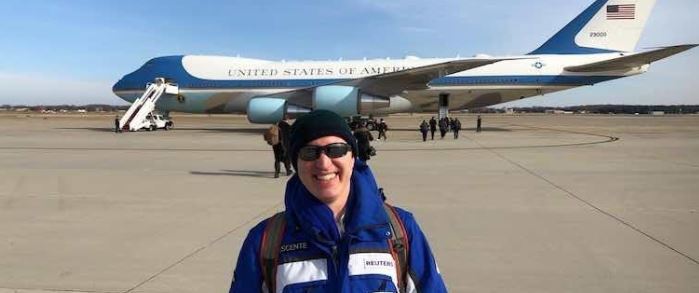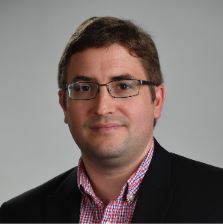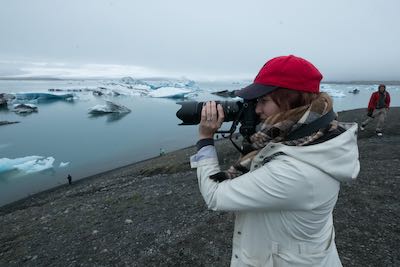
For years, President Trump had generally avoided formal press briefings, preferring to comment via Twitter and in impromptu sessions with reporters on the White House lawn. But in mid-March, with the coronavirus spreading across the country and killing thousands each day, he began holding daily 5 p.m. briefings.

Jeff Mason, a White House correspondent for Reuters, was in the briefing room along with about 14 other reporters, their ranks reduced from the usual 49 in an attempt at social distancing. An instructor for Georgetown University’s Master's in Journalism program, Mason had spoken in 2018 about what a privilege it was to work at the White House and have “a front seat to history.”
That was still true, of course; but the atmosphere had changed.
“It’s certainly scary,” Mason said. “It is scary to see so many people are dying—it’s devastating. And, of course, the economic devastation is also enormous. So it’s just very, very sad, and very difficult to cover.”
This story follows four reporters who are covering the pandemic, all of whom have connections to Georgetown’s graduate Journalism program. Mason and two of his colleagues, Jack Gillum of ProPublica and Ryan Teague Beckwith of Bloomberg Politics, teach in the program. Alumna Lezla Gooden graduated in 2016 and is now a television reporter for 23ABC in Bakersfield, Calif.
‘You Want to be Involved’
An expert in data reporting, Jack Gillum expected to spend this spring examining cybersecurity and disinformation in the 2020 presidential campaign. It’s a big story and an ongoing one, with huge implications for democracy.
But then the coronavirus story broke—what Gillum called “the most important story of a generation”—and he wanted to help with that as well.

“When you’re a reporter, you have to be able to pivot quickly, especially on the big breaking news stories of the day…,” said Gillum, a ProPublica Senior Reporter. “You want to be involved in the big story.”
Data is critical to understanding and eventually containing the coronavirus, yet as of mid-April, conclusive data was still hard to come by. No one knows how many people are infected or where, in real-time, the virus is spreading. And, despite the numbers everyone sees in the media, we don’t know how many people have died from the disease because these statistics are incomplete.
In April, Gillum and two colleagues sought to show what many health experts suspected—that deaths in urban areas were being significantly undercounted. They looked at municipal records for “in-home” deaths in Boston, Detroit, and New York and found that, in all of these cities, the numbers were many times higher than during similar periods in years past. They also studied records from police scanners that confirmed when officers were sent to an at-home-death.
Epidemiologists and experts on mortality statistics helped them interpret the data. One of those experts, Mark Hayward, a sociologist at the University of Texas-Austin, told them that the rise in deaths, particularly in Massachusetts and Detroit, showed that an undercount was occurring and that they should regard the official coronavirus death counts “as just the tip of the iceberg.”
‘People Will be Helped or Hurt by These Decisions’
Past elections have given us “soccer moms,” “NASCAR dads,” and that hoariest of journalistic clichés: the guy in the diner. They all have their uses; they give readers a sense of what people are thinking beyond the Washington, D.C, beltway.
But Ryan Teague Beckwith, a reporter for Bloomberg Politics, believes he’s come up with a better stand-in for a demographic that might decide the 2020 election: the “Panera Bread Voter.” They’re a big group: women in relatively prosperous suburban areas who voted for Trump in 2016 but now appeared to have soured on him.

“That presents a challenge,” Beckwith said. “Because that beltway bias is real.”
One advantage for Beckwith is that his job requires more analysis than legwork. In late March, for example, he wrote about the cost and complexities of implementing nationwide mail-in balloting in November because of the virus.
Recently, he also wrote about the theory of “negative partisanship,” the idea that voters in our internet-saturated, politically polarized world “are driven more by dislike of their political opponents than by their liking of people in their own party.” That was true in 2016, and it looks to be perhaps even more valid this year.
The presidential campaign is like a sport—a horse race, to use another cliché. But Beckwith said journalists need to go beyond this facile, sports-like coverage and remind the public that elections do indeed have consequences, that they shape the direction of the country for years to come.
“You have to remember,” he said. “that, as much as you write about the game and who’s up or who’s down, that also that there will be people who will be hurt or helped by these decisions.”
‘We Want to Get it Right’
The man on the phone was angry, hurt, and confused, and he was taking it out on Lezla Gooden, a television reporter for 23ABC in Bakersfield, Calif.

Gooden had been with the station for only a year, but she understood. As a reporter covering breaking news, she had made enough of these kinds of calls to know that the man was not attacking her personally: He had just lost his sister to COVID-19. She was the first person in the sprawling Kern County to die of the disease.
It’s Gooden’s job, as always in these cases, to find out as much about the victim’s life and death as possible, while also being respectful toward her close relatives. It can be a difficult, imperfect balancing act.
“I always reach out to the family because I want you to have the opportunity to tell your loved one’s story,” she recalled telling him. “We don’t want them to be just another name and face. And we want to get it right.”
What made it harder for Gooden was this: the victim’s name was already out on social media—along with some hurtful misinformation that her family had all tested positive for the virus. Now family members were getting threatening posts and people accusing them of ignoring social distancing and even spreading the virus intentionally.
Even though she and her station were not to blame, Gooden felt she had to apologize and speak for the entire profession. She told him that good journalists don’t spread rumors, that they don’t deal in “fake news” and work very hard to be accurate.
She had a short story on that night’s 6 p.m. newscast, and when she called the family the next day the mood had changed. They thanked her for her work and said they were ready to talk with her at length.
A portion of that interview ran the next night—the first comprehensive account from family members of the life and death of a mother, grandmother, business owner, and committed member of the community. But the station didn’t stop there: it made the entire 20-minute segment available online.
Unedited, the interview must have made some viewers wonder about Gooden’s competence with the camera, she said, because she was periodically zooming in and out and trying different angles and lighting.
In the end, however, that wasn’t a big concern, just as getting the story first wasn’t as important as getting it right and being respectful of the people most affected.
It was a public service.
